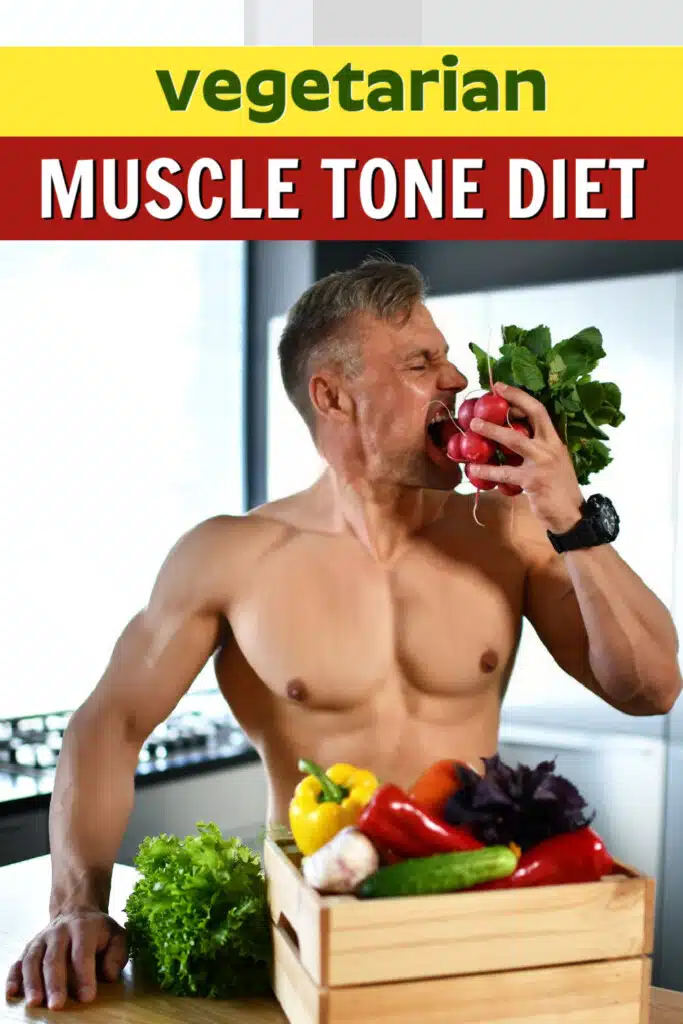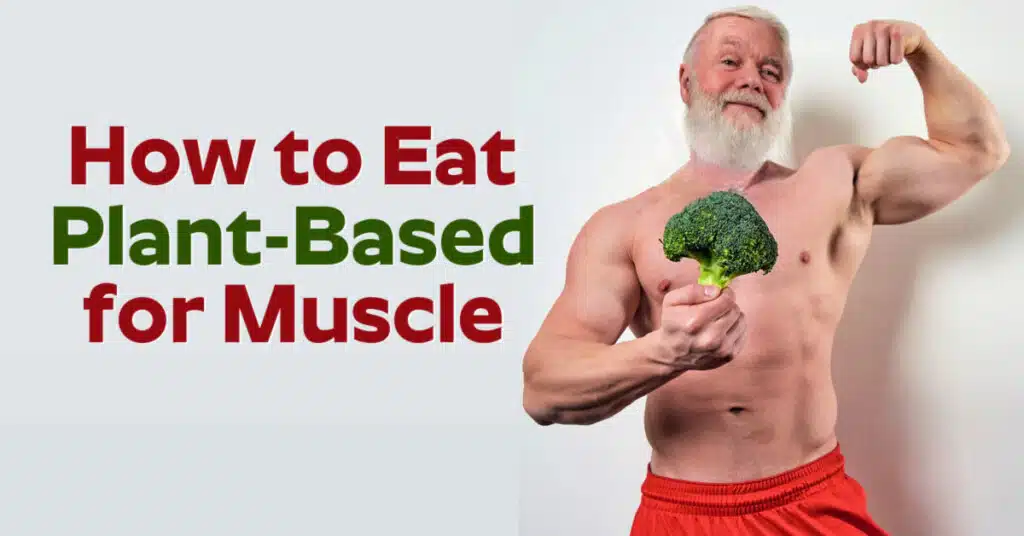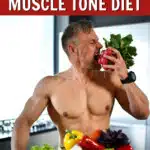Eating a vegetarian muscle-building diet for 30 days can help tone your physique while enhancing your overall health and well-being.
Contrary to the misconception that vegetarians struggle to get enough protein, a carefully planned vegetarian diet can be a powerful tool for muscle growth.
In this comprehensive guide, I explain the world of vegetarian muscle-building, discussing the benefits of this diet for your body and the planet – and providing you with a nourishing and balanced plant-based menu that you can try for 30 days, to fuel your muscles naturally.
This meal plan is for both men and women.
If you are an athlete or physically active, see the bottom of this article, where I provide ideas for additional protein boosts as needed.
Plant-Powered Muscle Tone: Comprehensive Vegetarian Meal Plan
Before I dive into the specifics of muscle-building on a vegetarian diet, let’s establish a high-protein vegetarian diet plan that can serve as a foundation for replacing fat cells with sculpted muscle tone.
This plan focuses on natural protein sources and other essential nutrients to optimize muscle growth.
This is a Lacto-Ovo Meal Plan
A lacto-ovo vegetarian is a type of vegetarian who excludes meat, poultry, and seafood from their diet but includes some dairy products (lacto) and eggs (ovo).
Lacto-ovo vegetarians primarily rely on plant-based foods such as vegetables, fruits, grains, legumes, nuts, seeds, dairy, and eggs for nutritional needs.

Lacto-ovo vegetarians abstain from consuming animal flesh – including beef, poultry, fish, and shellfish – distinguishing them from pescatarians (who eat fish and seafood) and vegans (who exclude all animal products, including dairy and eggs).
Lacto-ovo vegetarians aim to enjoy a vegetarian lifestyle while still obtaining essential nutrients like protein, calcium, and vitamin B12 from dairy products and eggs.
Ethical, environmental, or health concerns often motivate this dietary choice.
The only dairy in the following meal plan is either lactose-free or fermented and, therefore, more easily digested.
Plant-Powered Physique: Vegetarian Meal Plan for Building Muscle & Enhancing Health
Research indicates that improving one’s weekly diet can boost immunity.
If you’re interested in enhancing your health while losing fat, here’s how you can use the following menu guide most effectively.
I suggest using an online calculator to determine your ideal daily allotment of calories, then modify the portion sizes of the following menu items so that the entire day of eating fits within your caloric allotment.
A Protein-Packed Smoothie for Breakfast
Winning is when you can get a green vegetable into your body before 10 a.m. each morning! This shake will help you accomplish that.
- Start your day with a protein-rich smoothie made from plant-based protein powder, coconut milk, spinach, a bit of frozen mango, and chia seeds. This concoction provides essential amino acids to kickstart muscle repair and growth.
If you happen to have autoimmune issues and are sensitive to lectins, you can skip the chia seeds. I prefer to presoak my chia seeds in a bit of water for 15 minutes before pouring the resulting gel into the blender.
My favorite plant-protein powder is unsweetened and comprised mostly of rice protein and hemp protein. This comes in very handy on days when I’m more physically active because I can this powder to a smoothie for a fast protein boost.
Mid-Morning Snack: Greek Yogurt with Berries
- Unsweetened Greek yogurt is a vegetarian’s secret weapon for protein. Top it with fresh berries and cinnamon for added antioxidants and vitamins to support overall health.
As a vegan alternative, you could have cultured coconut milk “yogurt,” although this wouldn’t have the protein punch of Greek yogurt.
Lunch: Quinoa and Chickpea Salad
- Quinoa and chickpeas are both excellent sources of plant-based protein. Combine them with a variety of colorful vegetables and a tahini dressing for a satisfying, muscle-building meal.
Afternoon Snack: Almonds and Edamame
- Almonds and edamame are packed with protein and healthy fats. Munch on these for sustained energy and muscle recovery throughout the day.
Dinner: Lentil and Vegetable Stir-Fry
- Lentils are a powerhouse of protein, fiber, and essential nutrients. Stir-fry them in avocado oil with a medley of vegetables and your favorite seasonings for a delectable evening meal.
Be sure not to let the avocado oil get so hot that it reaches “smoke point.” When oil smokes, it can lose its beneficial properties and even become a bit harmful.
Benefits of a Vegetarian Muscle-Building Diet for Your Body
There can be abundant benefits to eating a plant-based diet.
- Rich in Protein: Contrary to popular belief, vegetarian diets can be abundant in protein. Incorporating plant-based sources like legumes, tofu, tempeh, and seitan ensures you get the protein needed for muscle growth.
- Lower in Saturated Fat: Vegetarian diets tend to be lower in saturated fat than meat-based diets. This can lead to better heart health and overall well-being.
- High in Fiber: Plant-based diets are typically high in fiber, promoting healthy digestion and regular bowel movements. A healthy gut is essential for nutrient absorption and muscle recovery.
- Lower Risk of Chronic Diseases: Vegetarian diets have been linked to a reduced risk of chronic diseases such as heart disease, type 2 diabetes, and certain types of cancer, which can support long-term fitness goals.

Eating a vegetarian diet is not for everyone. I strongly encourage you to ask your medical doctor before significantly changing your eating patterns. And please don’t skip your annual physical exam, as the blood lab work results can be invaluable for understanding if how you’re eating is helping or harming you.
Benefits of a Vegetarian Muscle-Building Diet for the Planet
Eating plant-based can not only be helpful to your body, it also can help the world at large.
- Reduced Carbon Footprint: Vegetarian diets have a lower environmental impact than diets heavy in animal products. Reduced meat consumption means fewer greenhouse gas emissions and less strain on natural resources.
- Preservation of Biodiversity: The demand for meat production often leads to deforestation and habitat destruction. Choosing a vegetarian diet can help preserve biodiversity and protect natural ecosystems.
- Water Conservation: Livestock farming consumes vast amounts of water. Shifting towards a vegetarian diet can contribute to water conservation, a critical resource for the planet.
Additional Menu Ideas for Vegetarian Muscle-Building Diet
Here are a few more nourishing and balanced plant-based menu ideas to support your muscle-building goals.
Power-Packed Lunch Wrap
- Enjoy a lunch wrap filled with hummus, roasted vegetables, and falafel. This satisfying meal is a protein and fiber powerhouse. I like the wraps made from rice.
Energizing Snack Attacks
- Vegetable Sticks: Almost every day, I have vegetable sticks, which I meal prep on Mondays and Thursdays and stack in the refrigerator in food-storage containers. My vegetable sticks are simple: cucumber, carrot, celery, red or yellow bell pepper, and jicama (or radish). As a reward for eating extra veggies, I end with a square of dark chocolate.
- Chocolate-Banana Protein Shake: If you are an athlete or have a higher-than-average level of physical activity, you might benefit from a higher protein intake. Whey protein isolate powder (make sure the label says “isolate” because it’s lactose-free) can be helpful. Blend it with a peeled frozen banana, a teaspoon of cocoa, some coconut milk, six pecans, and ice for an extra protein shake during the day.
- Eggs, Olive Oil, Sea Salt: Do you still require even more protein on a particular day? Scramble a couple of eggs in olive oil and top with sea salt.
If you’re serious about adding muscle tone to your body, I suggest using one of the online protein calculators to figure out how many grams of protein you need daily to achieve your physique goals, then double-check (and triple-check) to make sure your typical daily menu meets that protein quota.
Satisfying Supper
- Try a delicious dinner of tofu and broccoli stir-fry. Tofu is an excellent source of plant-based protein and can be customized with (a sparing amount of) your favorite sauce.
Plant-Based Body: Conclusion on 30-Day Vegetarian Menu for Better Muscle Tone
Keep in mind that you need a broad range of micronutrients to thrive. To that end, I suggest consuming abundant multi-colored vegetables, both cooked and raw.
You can have up to 9 cups of loose vegetables daily from the full spectrum of colors on an anti-inflammatory diet.
Not only will that help you reach your vitamin and mineral requirements, but when you’re full of vegetables and their accompanying fiber, you won’t have much room left for disadvantageous conveyor-belt, simple-carbohydrate foods (those addictive snacks that come in boxes or bags).
Embracing a vegetarian muscle-building diet can be a game-changer for your health and the environment.
With careful planning and a diverse selection of plant-based foods, you can meet your protein needs, support muscle growth, and contribute to a more sustainable planet.
Make the switch to plant-based power for growth and reap the numerous benefits that vegetarianism offers. Or, alternatively, try it for 30 days only – and at the end of that trial period, you can determine if you feel and look better as a result.
